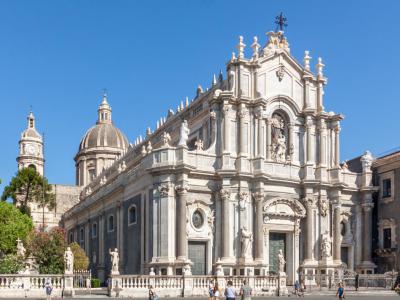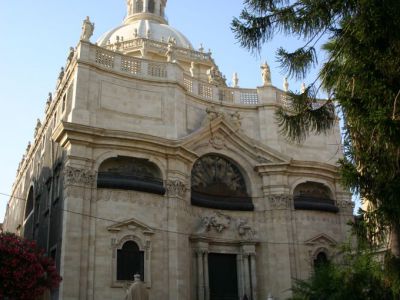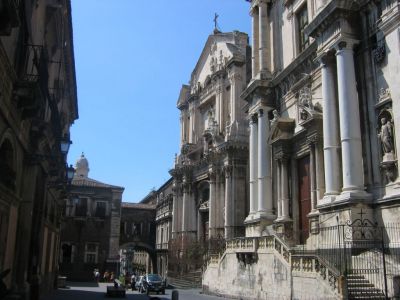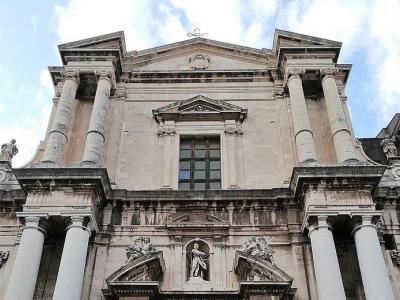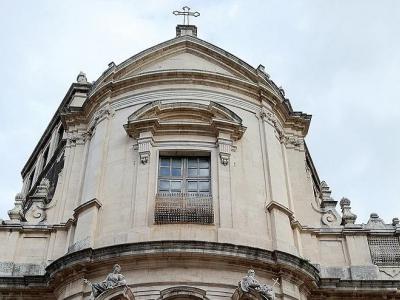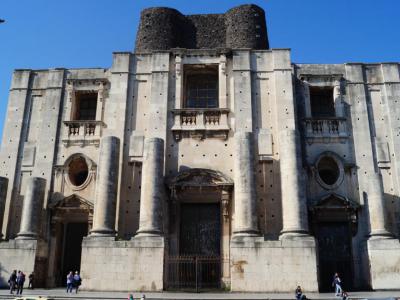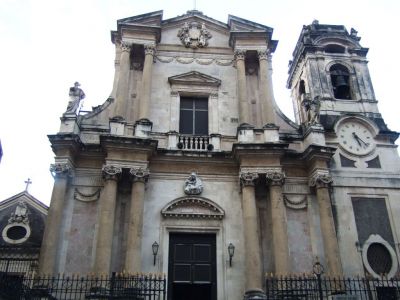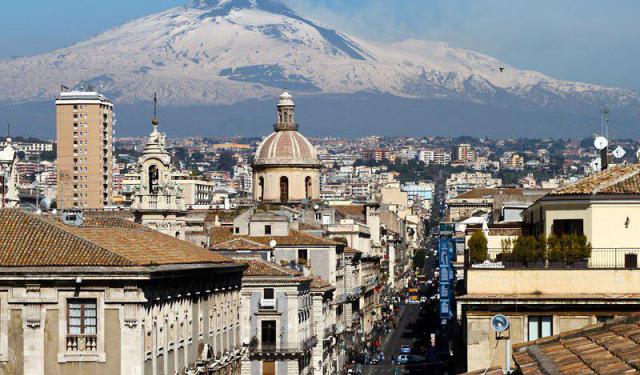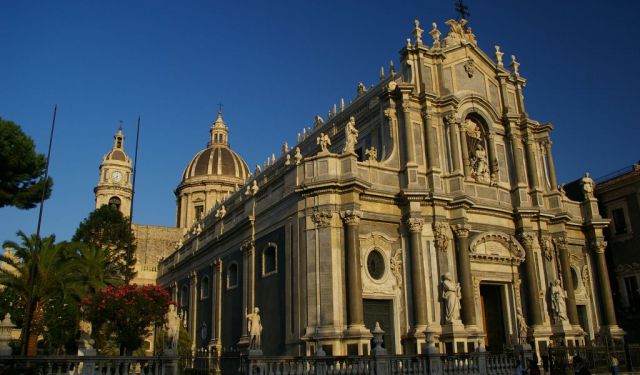
Historical Churches Walking Tour (Self Guided), Catania
Just as many other Italian destinations, the Sicilian city of Catania is full of churches, especially in the historic center, where the presence of religious sites is particularly high! A good number of local churches date back centuries, and as such represent marvelous pieces of architecture, adding much character to the area. It is also commonplace to find inside most of them, be it a duomo, basilica, chiesa or cattedrale, at least one spectacular piece of art amid the rich decorations of gold, bronze and marble.
All the “older” churches of Catania – styled Baroque – emerged in the 18th century. The reason for that is simple, as the history of the city is split between “before” and “after” the earthquake of January 9, 1693 which saw Catania largely destroyed. Here are some of the most impressive local churches built since:
The Cathedral of Catania – aka Saint Agatha’s Cathedral, named after the “Santuzza” protector of the city; the massive structure shows a characteristic contrast between the gray and white marble used for decorations.
The Abbey of Saint Agata – right next to the Cathedral, completed in 1735 and regarded as a jewel of Sicilian Baroque; the masterpiece of the architect Giovanni Battista Vaccarini, designer of the post-earthquake Catania.
The San Giuliano Church – seen by many as the “pearl” of the city’s 18th-century reconstruction.
The Monastery of St. Nicholas Arena – one of the largest churches in Sicily, with a long and troubled history, predating the 1693 earthquake.
To explore these and other historic places of worship in Catania in more detail, take this self-guided walking tour.
All the “older” churches of Catania – styled Baroque – emerged in the 18th century. The reason for that is simple, as the history of the city is split between “before” and “after” the earthquake of January 9, 1693 which saw Catania largely destroyed. Here are some of the most impressive local churches built since:
The Cathedral of Catania – aka Saint Agatha’s Cathedral, named after the “Santuzza” protector of the city; the massive structure shows a characteristic contrast between the gray and white marble used for decorations.
The Abbey of Saint Agata – right next to the Cathedral, completed in 1735 and regarded as a jewel of Sicilian Baroque; the masterpiece of the architect Giovanni Battista Vaccarini, designer of the post-earthquake Catania.
The San Giuliano Church – seen by many as the “pearl” of the city’s 18th-century reconstruction.
The Monastery of St. Nicholas Arena – one of the largest churches in Sicily, with a long and troubled history, predating the 1693 earthquake.
To explore these and other historic places of worship in Catania in more detail, take this self-guided walking tour.
How it works: Download the app "GPSmyCity: Walks in 1K+ Cities" from Apple App Store or Google Play Store to your mobile phone or tablet. The app turns your mobile device into a personal tour guide and its built-in GPS navigation functions guide you from one tour stop to next. The app works offline, so no data plan is needed when traveling abroad.
Historical Churches Walking Tour Map
Guide Name: Historical Churches Walking Tour
Guide Location: Italy » Catania (See other walking tours in Catania)
Guide Type: Self-guided Walking Tour (Sightseeing)
# of Attractions: 7
Tour Duration: 1 Hour(s)
Travel Distance: 1.6 Km or 1 Miles
Author: vickyc
Sight(s) Featured in This Guide:
Guide Location: Italy » Catania (See other walking tours in Catania)
Guide Type: Self-guided Walking Tour (Sightseeing)
# of Attractions: 7
Tour Duration: 1 Hour(s)
Travel Distance: 1.6 Km or 1 Miles
Author: vickyc
Sight(s) Featured in This Guide:
- Cathedral of Catania
- Badia di Sant'Agata (Church of the Abbey of Saint Agata)
- Chiesa San Benedetto (Church of St. Benedict)
- San Francesco Borgia (Church of Saint Francis Borgia)
- Chiesa di San Giuliano (Church of San Giuliano)
- Monastery of St. Nicholas Arena
- Santuario di Santa Maria dell'Aiuto (Church of Santa Maria dell'Aiuto)
1) Cathedral of Catania (must see)
Agatha was a pious virgin from a noble Catania family in 231 AD. The Roman prefect Quintianus made amorous moves on her. She rebuffed him. He martyred her. But things went bad for Quintianus. His horse kicked him in the river. He hasn't been seen since.
The Cathedral of Catania, also known as Cathedral of Saint Agatha, stands in the Cathedral Square (Piazza del Duomo). It is built in Italian Baroque style. The facade was fashioned in 1700 after a devastating earthquake in 1693. It has three levels with niches and columns of Corinthian granite.
The main entrance has a carved wooden door showing 32 plaques of the life of the Saint. The dome was created in 1802. The bell tower is a rebuilt. A parvis with a white stone balustrade harbors five statues of saints in Carrara marble.
The interior has a Latin Cross plan and three naves. The apse dates from the 12th century. In the north transept is the Chapel of the Holy Crucifix. The cathedral holds the tombs of Vincenzo Bellini, the great Italian composer, and King Frederick III, John of Randazzo and Constance of Aragon.
They say Saint Agatha protects Sicily against enemies, corrupt officials and even Mount Etna. Carved into the facade of the cathedral are the letters N.O.P.A.Q.V.I.E. which are the initial letters of each word in a sentence in Latin that says "Agatha will revenge any injustice perpetrated by those who offend her land".
A promise that has been kept for 1,800 years.
The Cathedral of Catania, also known as Cathedral of Saint Agatha, stands in the Cathedral Square (Piazza del Duomo). It is built in Italian Baroque style. The facade was fashioned in 1700 after a devastating earthquake in 1693. It has three levels with niches and columns of Corinthian granite.
The main entrance has a carved wooden door showing 32 plaques of the life of the Saint. The dome was created in 1802. The bell tower is a rebuilt. A parvis with a white stone balustrade harbors five statues of saints in Carrara marble.
The interior has a Latin Cross plan and three naves. The apse dates from the 12th century. In the north transept is the Chapel of the Holy Crucifix. The cathedral holds the tombs of Vincenzo Bellini, the great Italian composer, and King Frederick III, John of Randazzo and Constance of Aragon.
They say Saint Agatha protects Sicily against enemies, corrupt officials and even Mount Etna. Carved into the facade of the cathedral are the letters N.O.P.A.Q.V.I.E. which are the initial letters of each word in a sentence in Latin that says "Agatha will revenge any injustice perpetrated by those who offend her land".
A promise that has been kept for 1,800 years.
2) Badia di Sant'Agata (Church of the Abbey of Saint Agata)
Badia di Sant'Agata or Abbey of St Agatha is an 18th-century Baroque-style Roman Catholic church attached to the female convent, and is situated just across the street from the left transept of the Catania Cathedral.
The nunnery was founded in 1620, under the Benedictine rule, and was dedicated, along with a half-dozen local churches, to St Agatha of Sicily, patron of Catania. The original convent was razed by the 1693 earthquake, which killed 15 of the 28 nuns then present.
Reconstruction was slow, and was initially confined to building cloisters for the nuns and a fence around the perimeter.
In 1736, the construction of a new church, replacing the destroyed original, got underway to the design of Giovanni Battista Vaccarini. The façade was complete by 1742, featuring a 17th-century portal, designed by Giovanni Maria Amato, which had survived the earthquake. The octagonal dome was not complete until 1768. Inside the church there is a metal grill behind the main altar, with a viewing balcony allowing nuns to attend the mass, whilst being separated from the public. The base of the dome allows for views of the city and the looming volcano of Mount Etna.
The interior is an elongated octagon with white marble floors and yellow Castronovo marble, a material selected by the architect Nicolò Daniele. In 1782, Giovanni Battista Marino, Mario Biondo and Giovanni Battista Amato completed the stucco altarpiece statues in the side altars, featuring St Benedict, the Immaculate Conception, St Joseph, and St Euplio. The main altar has a Statue of Saint Agatha. Hung beneath the dome is a large glass chandelier.
The church consecration ceremony took place in 1796. The most recent renovation, from an earthquake damage sustained in 1990, was done in 2012.
The nunnery was founded in 1620, under the Benedictine rule, and was dedicated, along with a half-dozen local churches, to St Agatha of Sicily, patron of Catania. The original convent was razed by the 1693 earthquake, which killed 15 of the 28 nuns then present.
Reconstruction was slow, and was initially confined to building cloisters for the nuns and a fence around the perimeter.
In 1736, the construction of a new church, replacing the destroyed original, got underway to the design of Giovanni Battista Vaccarini. The façade was complete by 1742, featuring a 17th-century portal, designed by Giovanni Maria Amato, which had survived the earthquake. The octagonal dome was not complete until 1768. Inside the church there is a metal grill behind the main altar, with a viewing balcony allowing nuns to attend the mass, whilst being separated from the public. The base of the dome allows for views of the city and the looming volcano of Mount Etna.
The interior is an elongated octagon with white marble floors and yellow Castronovo marble, a material selected by the architect Nicolò Daniele. In 1782, Giovanni Battista Marino, Mario Biondo and Giovanni Battista Amato completed the stucco altarpiece statues in the side altars, featuring St Benedict, the Immaculate Conception, St Joseph, and St Euplio. The main altar has a Statue of Saint Agatha. Hung beneath the dome is a large glass chandelier.
The church consecration ceremony took place in 1796. The most recent renovation, from an earthquake damage sustained in 1990, was done in 2012.
Sight description based on Wikipedia.
3) Chiesa San Benedetto (Church of St. Benedict)
In 1334 the Church of Saint Benedict of Nursia was completed. In 1693, like most of Catania, the church was destroyed by the great earthquake. Only five nuns lived to tell the tale. In 1714 the church was rebuilt but the monastery was not finished until 1763. Rebuilding was mainly the the work of architect Giovanni Battista Vaccarini.
The facade has pilasters and several statues. The pediment of the tympanum has two feminine figures representing Fortitude and Temperence. Above the entrance is a statue of the Virgin Mary. The wooden main door has panels showing scenes from the life of Saint Benedict. The marble Angel Staircase has angels and railings of wrought iron.
The interior has one nave. It is lushly adorned with stucco and frescoes on the walls, vault and semi-dome. Artists include Matteo Desiderato and Giovanni Tuccari. Pictures of the life of Saint Benedict are everywhere in scenes both lively and cheerful. The main altar is of polychrome marble with panels of bronze.
The church is open Tuesday, Friday and Saturday from 10am to 5pm.
The facade has pilasters and several statues. The pediment of the tympanum has two feminine figures representing Fortitude and Temperence. Above the entrance is a statue of the Virgin Mary. The wooden main door has panels showing scenes from the life of Saint Benedict. The marble Angel Staircase has angels and railings of wrought iron.
The interior has one nave. It is lushly adorned with stucco and frescoes on the walls, vault and semi-dome. Artists include Matteo Desiderato and Giovanni Tuccari. Pictures of the life of Saint Benedict are everywhere in scenes both lively and cheerful. The main altar is of polychrome marble with panels of bronze.
The church is open Tuesday, Friday and Saturday from 10am to 5pm.
4) San Francesco Borgia (Church of Saint Francis Borgia)
San Francesco Borgia is a Roman Catholic church adjacent to the former Collegio Gesuita, and standing parallel to the church of San Benedetto. The building is now mainly used for exhibits, and still holds much of the original Jesuit artwork. The church is presently deconsecrated and used for cultural activities by the Soprintendenza Regionale ai Beni Culturali.
The facade has a more classical front, with five statues of Jesuit saints. The one in the center, over the portal is the titular saint, while the flanking lower two are Ignatius Loyola and Francis Xavier. The upper statues depict Aloysius Gonzaga and Stanislaus Kostka.
The interior layout of the church is of a Latin cross, with a central nave and two aisles with chapels. Most of the interior was completed by 1740. The first altar on the right has an altarpiece depicting the Vision of Madonna and Child to San Giovanni Francesco Regis while in agony by Luciano Foti (1694-1779). The second altar on the right depicts the Saints Stanislaus Kostka and Aloysius Gonzaga by Giovanni Tuccari (1667-1743). The main altar is rich in polychrome marble and sculptural decorations by Giovanni Battista Marino. Part of it was vandalized in the 1980s. The main altarpiece is a copy (1567) of the Madonna della Neve, found in Santa Maria Maggiore, Rome. The work was donated by Francesco Borgia himself.
At the base of the dome there are statues of four evangelists. The frescoes depict the Triumph of St Ignatius and the Jesuits over heresy with a glory of Saints and Martyrs. The apse has painted curtains in a trompe-l'œil effect.
In the altars on the left there are two altarpieces, featuring St Agatha visited in jail and a Glory of St Joseph.
The facade has a more classical front, with five statues of Jesuit saints. The one in the center, over the portal is the titular saint, while the flanking lower two are Ignatius Loyola and Francis Xavier. The upper statues depict Aloysius Gonzaga and Stanislaus Kostka.
The interior layout of the church is of a Latin cross, with a central nave and two aisles with chapels. Most of the interior was completed by 1740. The first altar on the right has an altarpiece depicting the Vision of Madonna and Child to San Giovanni Francesco Regis while in agony by Luciano Foti (1694-1779). The second altar on the right depicts the Saints Stanislaus Kostka and Aloysius Gonzaga by Giovanni Tuccari (1667-1743). The main altar is rich in polychrome marble and sculptural decorations by Giovanni Battista Marino. Part of it was vandalized in the 1980s. The main altarpiece is a copy (1567) of the Madonna della Neve, found in Santa Maria Maggiore, Rome. The work was donated by Francesco Borgia himself.
At the base of the dome there are statues of four evangelists. The frescoes depict the Triumph of St Ignatius and the Jesuits over heresy with a glory of Saints and Martyrs. The apse has painted curtains in a trompe-l'œil effect.
In the altars on the left there are two altarpieces, featuring St Agatha visited in jail and a Glory of St Joseph.
Sight description based on Wikipedia.
5) Chiesa di San Giuliano (Church of San Giuliano)
The Church of San Giuliano is a must-see in Catania – considered one of the city’s most beautiful places of worship. It stands on the site of an older church that had been razed by a 1693 earthquake.
The present late-Baroque building was constructed between 1739 and 1751 using the designs by Giuseppe Palazzotto and Vincenzo Caffarelli, and is dedicated St Julian the Hospitaller. The temple has an elaborate convex façade, with the upper story windows shielded by a dense iron grate, once used by the Benedictine nuns of the adjacent convent to observe the colorful procession on the day of Sant'Agata. The façade pediment holds a reclining maiden, sculpted by Gaspare Ciriaci. The entrance door carries a cross of the Order of the Holy Sepulchre, who restored the church after 1939.
The interior nave is an elongated asymmetric octagon with a main altar and four shallow circumferential minor altars. The main altar in polychrome was designed by Giovanni Battista Vaccarini, and sculpted by Giovanni Battista Marino. The statuettes, flanking the throne and painted cross, depict allegories of Faith and Charity. The minor altarpieces depict: Madonna of the Graces with St Joseph and St Benedict; St Anthony Abbot in Ecstasy; Scenes of the Life of St Julian and his Martyrdom; Crucifixion scene with Mary of the Sorrows, Mary Magdalen, and St John the Evangelist.
The cupola fresco, depicting God the Father and St Peter, was painted by Giuseppe Rapisardi in 1842.
The present late-Baroque building was constructed between 1739 and 1751 using the designs by Giuseppe Palazzotto and Vincenzo Caffarelli, and is dedicated St Julian the Hospitaller. The temple has an elaborate convex façade, with the upper story windows shielded by a dense iron grate, once used by the Benedictine nuns of the adjacent convent to observe the colorful procession on the day of Sant'Agata. The façade pediment holds a reclining maiden, sculpted by Gaspare Ciriaci. The entrance door carries a cross of the Order of the Holy Sepulchre, who restored the church after 1939.
The interior nave is an elongated asymmetric octagon with a main altar and four shallow circumferential minor altars. The main altar in polychrome was designed by Giovanni Battista Vaccarini, and sculpted by Giovanni Battista Marino. The statuettes, flanking the throne and painted cross, depict allegories of Faith and Charity. The minor altarpieces depict: Madonna of the Graces with St Joseph and St Benedict; St Anthony Abbot in Ecstasy; Scenes of the Life of St Julian and his Martyrdom; Crucifixion scene with Mary of the Sorrows, Mary Magdalen, and St John the Evangelist.
The cupola fresco, depicting God the Father and St Peter, was painted by Giuseppe Rapisardi in 1842.
Sight description based on Wikipedia.
6) Monastery of St. Nicholas Arena (must see)
Formerly a Benedictine establishment, the monastery is located at Dante Square in Catania. It is part of Val di Noto Works Heritage Site. There are no monks to be found on the premises but the humanities department of the University of Catania has found a home here.
The monastery was founded in 1558 and dedicated to San Nicolo "l'Arena." The monastery is in the center of town. It stands beside the Church of San Nicolo l'Arena. After the 1669 eruption of Mount Etna and the 1693 earthquake, the monastery was level with the ground.
Rebuilding commenced in 1702 and continued until the monastery was confiscated by the government in 1866. The current monastery rests on top of the original one (what was left of it). It has a new cloister and area designed by Giovanni Battista Vaccarini.
The original monastery used a square floor plan. A cloister in the center was called the "marble" cloister. It had a marble colonnade and a clover shaped fountain with refined renaissance decorations. In 1693 all this was destroyed.
The "Marble" cloister was rebuilt with late baroque decorations. The Eastern Cloister was a new addition. A new area on the North side was also added.
Giancarlo De Carlo, architect, has said, "...the old meanings have been substituted by a new one that allows the old architecture get a new structure and an important role for the contemporary world."
The monastery was founded in 1558 and dedicated to San Nicolo "l'Arena." The monastery is in the center of town. It stands beside the Church of San Nicolo l'Arena. After the 1669 eruption of Mount Etna and the 1693 earthquake, the monastery was level with the ground.
Rebuilding commenced in 1702 and continued until the monastery was confiscated by the government in 1866. The current monastery rests on top of the original one (what was left of it). It has a new cloister and area designed by Giovanni Battista Vaccarini.
The original monastery used a square floor plan. A cloister in the center was called the "marble" cloister. It had a marble colonnade and a clover shaped fountain with refined renaissance decorations. In 1693 all this was destroyed.
The "Marble" cloister was rebuilt with late baroque decorations. The Eastern Cloister was a new addition. A new area on the North side was also added.
Giancarlo De Carlo, architect, has said, "...the old meanings have been substituted by a new one that allows the old architecture get a new structure and an important role for the contemporary world."
7) Santuario di Santa Maria dell'Aiuto (Church of Santa Maria dell'Aiuto)
The Church of Santa Maria dell'Aiuto is a beautiful parish church overlooking the square of the same name. The current temple was built on the ruins of the church of Saints Peter and Paul following the earthquake of 1693, and is designed by Antonino Battaglia and decorated by Michele Orlando.
Preceded by a wide staircase of about a dozen steps, the façade has a broken pediment with columns with modified ionic capitals, superimposed with two equally tall solid stone columns with Corinthian capitals. The lateral volutes are framed by two statues depicting Saints Peter and Paul. Flanking the left of the façade is a bell-tower with a clock, completed in the 19th century.
The interior contains a chapel housing a reduced-scale replica of the Holy House of Loreto and its marble screen added in the 1740s. There is also an elaborate reliquary in the altar of the Crucifix. The venerated icon of the Virgin is housed above the polychrome marble altar. Statues of St Peter and Paul and a depiction of God the Father frame the icon.
The second altar on the left contains a Crucifix with a wall of relics. The first altar on the right has a copy of the painting by Filippo Paladini depicting the Martyrdom of Saint Agatha; the original is housed in the Catania Cathedral.
Preceded by a wide staircase of about a dozen steps, the façade has a broken pediment with columns with modified ionic capitals, superimposed with two equally tall solid stone columns with Corinthian capitals. The lateral volutes are framed by two statues depicting Saints Peter and Paul. Flanking the left of the façade is a bell-tower with a clock, completed in the 19th century.
The interior contains a chapel housing a reduced-scale replica of the Holy House of Loreto and its marble screen added in the 1740s. There is also an elaborate reliquary in the altar of the Crucifix. The venerated icon of the Virgin is housed above the polychrome marble altar. Statues of St Peter and Paul and a depiction of God the Father frame the icon.
The second altar on the left contains a Crucifix with a wall of relics. The first altar on the right has a copy of the painting by Filippo Paladini depicting the Martyrdom of Saint Agatha; the original is housed in the Catania Cathedral.
Sight description based on Wikipedia.
Walking Tours in Catania, Italy
Create Your Own Walk in Catania
Creating your own self-guided walk in Catania is easy and fun. Choose the city attractions that you want to see and a walk route map will be created just for you. You can even set your hotel as the start point of the walk.
Catania Introduction Walking Tour
The old Sicilian word "katane" is often translated as "harsh ground" or "sharp stones." Black lava from Mount Etna has swamped the area many times. Other disasters include earthquakes, invasions and wars.
The original village of Katane was occupied by Greek settlers in the eighth century BC. During the first Punic War, Catania became a Roman city. The Vandals... view more
Tour Duration: 2 Hour(s)
Travel Distance: 3.8 Km or 2.4 Miles
The original village of Katane was occupied by Greek settlers in the eighth century BC. During the first Punic War, Catania became a Roman city. The Vandals... view more
Tour Duration: 2 Hour(s)
Travel Distance: 3.8 Km or 2.4 Miles
The Most Popular Cities
/ view all
